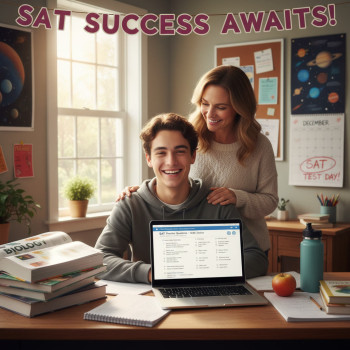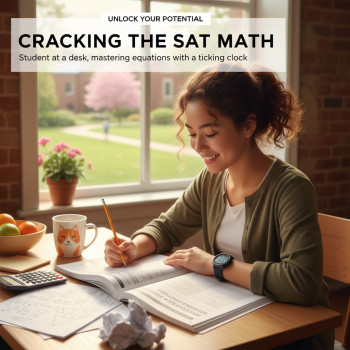Welcome — Why the Digital SAT Score Report Matters for Parents
When your student opens their Digital SAT score report for the first time, it can look like a compact document full of numbers, graphs, and phrases you only half-recognize. Take a breath: that confusion is normal. This report is more than a grade — it’s a map. It shows strengths, gaps, and opportunities to plan the next steps in the college application journey.
In this guide, we’ll walk through the score report together — in plain language, with real-world examples and practical next steps parents can use to support their student. I’ll also mention ways tailored support (for example, Sparkl’s personalized tutoring with 1-on-1 guidance and AI-driven insights) can fit naturally into a growing plan, where it helps most.
Overview: What You’ll See on the Digital SAT Score Report
The digital report is designed to be more visual and actionable than older paper reports. Key sections you’ll typically find include:
- Total score and section scores (Reading & Writing and Math)
- Percentiles — how your student compares to peers locally and nationally
- College and career readiness benchmarks
- Knowledge and Skills or Skills Insights — what specific content areas the student did well in and where they can improve
- Score sends and AP Potential indicators (when available)

Total Score: The Big Picture, and What It Really Means
The total score is the headline number colleges will see if you send scores — it combines Reading & Writing and Math. For the Digital SAT, think of the total score as a quick, overall snapshot. It’s important, but not the whole story. Admissions officers will often look at section scores, transcript strength, essays, extracurriculars, and recommendations too.
Parent tip: treat the total score as a starting conversation: celebrate what went well, and then turn to the parts of the report that tell you where growth is possible.
Section Scores: Reading & Writing and Math
Section scores break down your student’s performance in the two broad skills areas. These are useful because they point to domain-specific study actions. For example, a strong Math score and a weaker Reading & Writing score suggests focusing on comprehension strategies and evidence-based writing practice.
Percentiles and Comparison Data: Context Is Everything
Numbers without context can feel meaningless. Percentiles answer the question: how did my student do compared with other test takers? The report often shows percentiles by state, country, and all testers, giving layered context.
Here’s how to read percentiles practically:
- A 70th percentile means your student scored better than about 70% of peers — a strong position but remember college fit and major competitiveness matter.
- Look at both section percentiles; a student could be very competitive in Math but average in Reading & Writing.
- Use percentiles with your student’s GPA and course rigor to build a balanced list of reach, match, and safety schools.
Knowledge & Skills / Skills Insights: The Heart of the Digital Report
One of the most useful features in the digital era is the Knowledge and Skills information (often labeled Skills Insights). Rather than showing specific question answers, the report groups content into domains — such as algebra, problem solving, or command of evidence — and places student performance into bands. These bands help you understand what a student with that band typically knows and can do.
How parents can use Skills Insights:
- Targeted practice: if the report flags algebra fundamentals as a lower band, focus practice on that area instead of aimless review.
- Course selection: use these insights to decide whether summer math review or an advanced writing seminar is the better investment.
- Measure growth: retesting after a targeted plan is the clearest way to see progress in those domains.
Real-world example
Imagine Ella scored 1160 total: 640 Math and 520 Reading & Writing. The Skills Insights show she’s in a mid band for algebraic manipulation but in a lower band for inference and evidence-based reading. A focused plan that combines algebra drills with reading strategies would be far more effective than generic practice tests.
College & Career Readiness Benchmarks
The report includes benchmarks — score thresholds linked to likely readiness for college-level work. These benchmarks are a helpful lens, but they’re not absolute. A student above the benchmark is more likely to be ready for first-year college courses without remediation, while a student below the benchmark may benefit from targeted coursework before matriculation.
Parent perspective: benchmarks aren’t a final judgment — they’re a practical guide to planning coursework and summer prep.
Engagement and the BigFuture App: More Than Raw Numbers
For students who took the test through school-day digital administrations, the BigFuture School mobile app can deliver scores and college planning content. The app (and related engagement reports) often provide aggregate participation metrics and can connect score results to college search tools.

Common Parent Questions — Answered
1. How often can my student retake the Digital SAT?
Students can retake the SAT multiple times; the right rhythm depends on schedules, deadlines, and whether the student will use the new scores for college applications. Discuss retakes in the context of application timelines, scholarship deadlines, and the time needed for meaningful improvement.
2. Which scores should I send to colleges?
Policies vary: many colleges superscore (combine best section scores from multiple test dates), while others will consider the highest single test. Decide strategically: if a later test shows higher section scores, sending that one or allowing superscoring could be advantageous. Keep the college’s policy in mind, and aim to show growth.
3. Should I be worried about small dips in score?
Not usually. Small fluctuations happen. Focus on trends over time and whether the report reveals consistent gaps that can be addressed with targeted work.
Practical Next Steps: A Parent’s Action Plan
Turn the score report into a short-term plan that leads to measurable improvement. Here’s a straightforward roadmap you can use in the days and months after scores arrive.
- Step 1 — Celebrate and normalize the reaction. Take time to recognize effort.
- Step 2 — Review the Skills Insights together. Pick two priority areas: one strength to preserve and one weakness to address.
- Step 3 — Build a study timeline tied to the next target test date and school calendar.
- Step 4 — Choose focused resources: targeted practice sets, timed section work, and content review for flagged domains.
- Step 5 — Reassess after a practice test scheduled 6–10 weeks into the plan.
How to structure weekly practice
- 3 focused sessions per week: one Math fundamentals, one Reading strategy, one full timed section or mixed practice.
- Use short, high-quality sessions (40–60 minutes) rather than marathon study blocks.
- End each session with one concrete goal for the next session.
Table: Sample 8-Week Improvement Plan (Example)
| Week | Focus | Practice Structure | Measure |
|---|---|---|---|
| 1 | Diagnostic & Skills Insights review | Take a practice test; review Knowledge & Skills report | Baseline section scores |
| 2 | Math fundamentals | 3×40-min sessions: algebra, ratios, targeted problem sets | Timed math section accuracy |
| 3 | Reading strategies | Active reading drills, evidence-based questions | Question-level accuracy |
| 4 | Mixed practice & timing | 1 full digital section under test conditions | Section pacing metrics |
| 5 | Deep dive into weaker sub-skill | Targeted lessons, error logs, 1-on-1 check-in | Reduced error types |
| 6 | Practice test & review | Full practice test; skills mapping | Progress vs baseline |
| 7 | Polish and stamina | Timed sections; test-day simulation | Improved pacing & confidence |
| 8 | Final review & rest | Light review; mental preparation routines | Ready for test day |
When Personalized Tutoring Helps — and What to Look For
Not every student needs formal tutoring, but for many, targeted 1-on-1 guidance accelerates progress. Look for tutoring that:
- Starts with diagnostics aligned to the digital report’s Skills Insights
- Creates a tailored study plan that targets content domains, not just generic practice tests
- Includes regular check-ins and measurable milestones
- Uses data (practice performance, timed sections) to adapt instruction
For example, Sparkl’s personalized tutoring model offers 1-on-1 guidance, tailored study plans, expert tutors, and AI-driven insights to help focus effort where it will move the needle. That kind of targeted partnership can be especially useful when Skills Insights point to very specific content gaps — say, fractional equation setup or evidence-based reading strategies — because the tutor can design micro-lessons that aim directly at the weak points.
Beyond Scores: Supporting the Whole Student
Scores are a piece of the application puzzle, but the way students grow and learn from the process matters to colleges. Parents can support resilience and long-term learning by:
- Encouraging reflection: ask the student what surprised them and what they learned about their own study habits.
- Prioritizing balance: sleep, nutrition, and consistent schedules improve test performance more than last-minute cramming.
- Framing retakes as practice: growth over time tells a better story than a one-off number.
Interpreting Score Sends and Privacy Considerations
Score sending is controlled through the College Board account. Discuss with your student which colleges should receive scores and how many test dates to include. Also, be mindful of privacy — especially when using school-day digital testing portals and apps. Encourage your student to keep account credentials secure and to review any app permissions.
Common Misunderstandings — Quick Clarifications
- Misunderstanding: A single score defines college chances. Clarification: Admissions use many factors; scores are important but not decisive by themselves.
- Misunderstanding: Higher test frequency always helps. Clarification: Retake only when there’s a reasonable plan for improvement and time to prepare.
- Misunderstanding: Skills Insights are prescriptive for a lifetime. Clarification: They’re diagnostic — a snapshot that points to targeted next steps.
How to Talk About Scores With Your Student
Keep conversations constructive. Use questions that help your student reflect — for example:
- “Which parts felt easy, and which felt like they took more time?”
- “If we had six weeks to focus, what would you most want to improve?”
- “What supports (teacher, tutor, practice schedule) would make that plan realistic?”
These questions invite agency and partnership rather than anxiety, and they help the student own the preparation process.
When to Seek Additional Help
Consider professional support if your student:
- Has a clear skills gap in the report that isn’t improving with self-study
- Needs to raise scores quickly for application deadlines or scholarships
- Feels overwhelmed, anxious, or stuck despite regular practice
Tutoring or focused coaching can provide structure, accountability, and strategies that save time and reduce stress. Again, services that align tutoring to the Skills Insights and that use data-driven progress checks will typically offer the best return on investment.
Final Notes: A Balanced, Long-Term View
The Digital SAT score report is designed to give parents and students clearer, more actionable feedback than ever before. Use it as a diagnostic tool, not a verdict. Pair the insights with a thoughtful plan: targeted practice, realistic timelines, and support when needed. Celebrate progress — even small improvements — and keep the broader goals in mind: academic fit, personal growth, and a college list that reflects who your student is and what they want to study.
If you’re wondering where to start, begin by reviewing the Skills Insights together and selecting two concrete priorities for the next six weeks. If you’d like a structured, personalized approach, consider 1-on-1 tutoring that ties directly to those insights — services like Sparkl’s personalized tutoring can provide tailored study plans, expert tutors, and AI-driven insights to make each session efficient and targeted.
Quick Checklist: After You Get the Score Report
- Read the Skills Insights together and identify one strength and one area to improve.
- Create an 8-week plan linking practice sessions to specific subskills.
- Schedule a full practice test midway through the plan to measure progress.
- Decide on score sends based on colleges’ policies and application deadlines.
- Consider tailored tutoring if your student needs focused, data-driven support.
Closing Thought
As a parent, your calm presence and practical planning are invaluable. The Digital SAT score report hands you useful tools — percentiles for context, Skills Insights for targeted work, and benchmarks for planning. Combine those tools with steady encouragement, realistic timelines, and focused resources, and you’ll help your student not only improve scores but build skills that matter long after admissions decisions are final.
If you’d like, I can help you draft a personalized 8-week study calendar based on a sample score report or suggest conversation starters to use with your student. Just share what you’d like to focus on and we’ll make a plan together.


















No Comments
Leave a comment Cancel